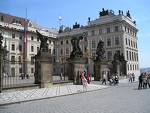Doubting Thomas vs. Hopeful Wilhelm
During Berlin’s January 2005 “
Long Night of Museums,” when the eponymous institutions stayed open all night with concerts and special programs in the spirit of a culturally edifying pub crawl, the darkness near Museum Island was illuminated by an enormous neon DOUBT. Seven letters, each 6 meters high and together spanning 38 meters, spelled out the German word “ZWEIFEL,” or “doubt,” across the top of a run-down, squat building shaped like a roachtrap.

This dark hulk was nearly drowned out by the light, but nonetheless there was no mistaking the Palace of the Republic [
Palast der Republik], the former seat of East German government, a boxy structure condemned by the unified government to sit uninhabited for a decade after the discovery of asbestos within. Or so the West claimed—many former Easterners viewed this “discovery” as a political calculation and pointed out that plenty of buildings in West Berlin were also full of asbestos but running smoothly. This claim is the tip of an iceberg of political contention surrounding the structure, a great societal difference of opinion on how to treat the past. This post will be the first in a series outlining aspects of the debate.
PALAST DES ZWEIFELS [Palace of Doubt], a work of art by Norwegian
Lars Ramberg, is a good place to begin. In the most immediate sense, the large “doubt” that stood atop the
Palast from January-March 2005 represented the controversy surrounding the proper use for the spot of land, one which lacks a doubtlessly “correct” answer. The spot where the
Palast stands, although not for much longer, was occupied for four hundred years by the Hohenzollern castle [
Schloss], the seat of Berlin’s ruling power. Its last incarnation was a Baroque façade designed by Andreas Schluter in 1706. After World War Two, the government of the Soviet-controlled German Democratic Republic claimed that the building was too war-damaged to be worth salvaging, and despite outcry, began demolishing it in September 1950. From 1973-6, they built a gold-glass rectangle that housed the German Democratic Republic’s parliament, as well as cultural exhibitions, performance space, cafes and even an ice-skating rink for the citizens, and proclaimed it a “Palace of the Republic.” After re-unification came the discovery of asbestos and resultant closure, and several years after that, in 1993, the government decided to tear it down, generating immediate consternation from former east-Berliners for whom the space had enormous cultural and sentimental significance. The debate was not entirely split along geographic lines; there were also many Westerners who saw the destruction of such a historically significant structure as disrespectful to anyone who had lived through Berlin’s division.
The controversial tear-down decision wasn’t truly put into action until January 2005, when Senator Ingeborg Junge-Reyer, the leader of Berlin’s municipal governing body, announced that demolition of the large, boarded-up wreck would soon begin. In its place, the Baroque Schloss would later be rebuilt, to the delight of lobbyists who had long dreamed of restoring central Berlin’s Prussian elegance. With support from the Norwegian embassy and several other organizations, Ramberg’s artwork was erected above the ultimately condemned Palast on January 20th, 2005. Ramberg explained that his work should cause “doubt and reflection from local and official levels about the pursuit according to continually new perspectives of the lost, past Utopia.”
[1] In other words, the latest Utopists should look at their Prussian aspirations with a critical, shall we say doubtful eye.
The work did not cause enough doubt. A year and a half later in fall 2006, the tear-down is in full swing and a patchwork of cloudy sky is visible between gaping holes in the
Palast’s steel skeleton. The project has not and will not stop ruffling feathers; many insist on referring to the
Schloss' rebuilding as a fool’s errand, an argument easy to support when the numbers are examined. The advocacy group currently fundraising for the
Schloss’ reconstruction,
Foerderverein Berliner Schloss e.V., hasn’t clarified where all the money will come from, other than to suggest, in full-color newsletters placed in the rooms of Berlin’s toniest hotels, that citizens “sponsor” different stages of the reconstruction. One can choose between supporting an individual architectonic element, such as a “colossal column capital” for 151,450 Euros, or be one of the “o

nly” 200,000 citizens to pledge 400 Euros over the course of ten years to make the 80 Million Euros needed to complete the elegant façade. In addition to someone who plays hopefully with numbers all day, the group also has a tremendous sense of optimism. The willpower behind the project can be traced back to one powerful personality, Wilhelm von Boddien, head of the
Schlossverein, seen at left in this picture.
In an interview with the
Berliner Morgenpost during the 2005 wave of controversy after the final decision to rip the
Palast down, von Boddien expressed nearly blind optimism. When asked how he planned to pay for the façade reconstruction, he responded by asserting that if merely a third of Berliners were willing to pay 50 euros each, there would be plenty of money for the project. He did not acknowledge that this may have been asking a lot from a city with almost 20% unemployment. He also didn’t do the math very well; 50 million is not 80, but no matter. Von Boddien also brushed aside concerns of Eastern resentment, enthusing, “I’m telling you, it’ll go like the
Frauenkirche [the reconstructed church in Dresden.] When the building begins, it will bring the opposition together.” He predicted that the reconstructed palace would be ready to open in October 2015, the 25th anniversary of German reunification, and could be celebrated with a week-long “
Volkfest” or “people’s party.”
[2]
Ramberg’s “doubt,” then, is both prescient and innaccurate. Von Boddien’s expectation that hundreds of thousands of individual citizens will elect to pay for the rebuilding, a hope he actually seems to believe, is dubious at best, especially for a society whose structure is not the American system of private wealth donated to public causes, but rather complete federal fiscal responsibility in the realm of culture and the arts. The
Schloss falls under this cultural rubric not least because plans for it include gallery and exhibition space. Yet if von Boddien’s assumptions appear as all else but dubious or misguided to him and his supporters: official
Schlossverein material trumpets an exuberant, exclamation-marked mood of jubilation. There is no doubt in their minds: the Schloss will be rebuilt, and it will be better than ever!
[1] “Dieser Zweifel wiegt schwer – Zehn tonnen, um genau zu sein.” Von SOF 29/30 Jan 2005, p. 1.
[2] “Das Stadtschloss steht 2015,” moderated by Katrin Schoelkopf, Berliner Morgenpost, 1 Feb 2005, p. 16
Images courtesy of iphppb.com,
Berliner Morgenpost and Foerderverein Berliner Schloss e.V.













